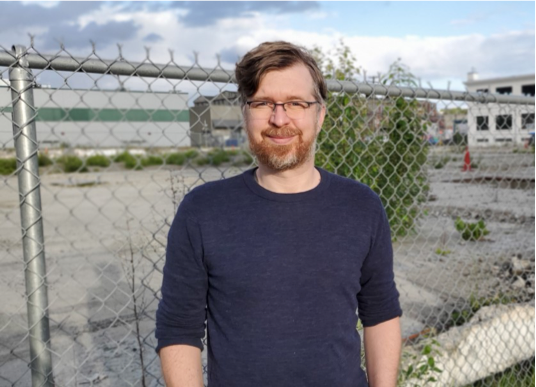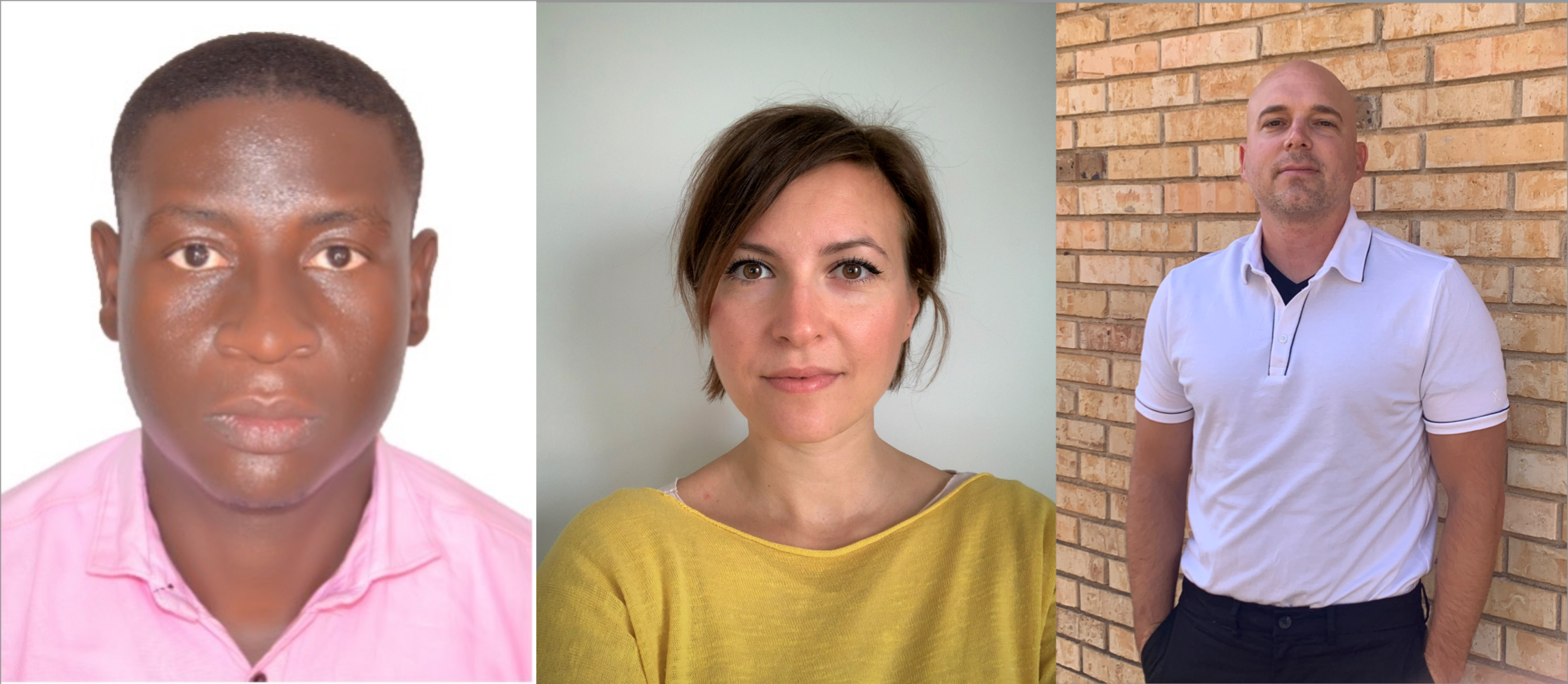The 2022 Early Career Researcher Prize was awarded to Michael Simpson for Fossil Urbanism: Fossil fuel flows, settler colonial circulations, and the production of carbon cities published in Urban Geography Volume 43, Issue 1. Honorable Mentions went to Hakimu Sseviiri, Chiara Valli, and Stephen Zigmund.
Current Issue
Volume 46, 8
2022 Prize Winners

Winner
Michael Simpson
I am thrilled and honoured to receive the 2022 Early Career Researcher Prize from Urban Geography. My paper, “Fossil Urbanism,” considers how fossil fuel energy infrastructures shape urban environments in ways that deepen and extend settler colonial and racial capitalist relations. A substantial body of literature has previously examined how hydrocarbon energy regimes reorder cities as sites of fossil fuel consumption. However, relatively little work has been done examining cities as sites of fossil fuel circulation – spaces through which oil and other fossil fuels are moved from sites of extraction to global markets. To help illustrate just how profoundly fossil fuel circulation structures the urban form, I consider the example of Vancouver, British Columbia. Underpinning this self-proclaimed “greenest city” lie extensive networks of ports, pipelines, pumping stations, storage tanks, railways, and other infrastructures which facilitate the smooth flow of fossil fuels across unceded Indigenous lands. These infrastructures have built up the urban environment as a key node within global hydrocarbon commodity chains in ways that impose risks and harms on some for the benefit of others.
However, the case of Vancouver also demonstrates that the geographies of circulation are never fixed or stable. As existing configurations of fossil capital periodically reach their limits, sites of extraction, production, and consumption shift and change. Circulatory infrastructures must be expanded, modified, or reoriented in turn, and urban space reorganized accordingly. In these moments of dynamic infrastructural change, the shoring up of racial colonial capitalist logics hinges on a spatial realignment of circulation. They are likewise moments of systemic vulnerability, which present strategic opportunities to disrupt and dismantle fossil urbanism, and to bring decolonized post-carbon urban futures into being.
This paper is a substantially re-worked chapter of my PhD dissertation, which I completed in the Department of Geography at the University of British Columbia (supervised by Philippe Le Billon and Trevor Barnes). I have continued to develop these themes in papers such as “The Settler Colonial City in Three Movements,” written with David Hugill, which explores how settler colonial cities are constituted through infrastructures that facilitate and constrain specific circulations and mobilities. I’m currently working on a book-length monograph on infrastructure of settler colonial and racial capitalist circulation in Vancouver.
I am grateful to receive this award, and I plan to donate the proceeds to Indigenous Climate Action.

Honorable Mention
Hakimu Sseviiri
I am a PhD candidate in Geographical Sciences at Makerere University, Uganda. My research practice and interests focus on health, spatial planning, humanitarian crises, urban development and infrastructure, food systems, gender, migration, inequalities, waste and climate resilience with emphasis on critical theories and policy change.
Our article, "Claiming Value from a Heterogeneous Waste Infrastructure in Kampala," uses the Heterogeneous Infrastructure Configurations (HICs) perspective as a theoretical lens that potentially accounts for a growing diversity manifested in Global South cities.Amid contested legitimacy of urban authorities, we describe how waste is waste is used as an object to govern the city, which in turn creates and shapes the waste HIC through a multiplicity of actors, practices, technologies, coalitions and across various scales. It is articulated that the waste HICs not only moves beyond the “people as infrastructure” notion which only accounts for the informal parts but also moves beyond the modernist infrastructure ideal that simply foregrounds the formal actors and wealthy enclaves- hence losing touch with the rugged textured reality of the city. We further appreciate that waste HICs have for long been in existence and are gaining legitimacy in the power corridors of the urban authority but the process of legitimization involves reworking power and material flows within the waste infrastructure. The paper strongly argues for the case of Kampala waste infrastructure that the lens of HIC opens up a clear possibility to better understand the complex and contested dynamics of Southern Cities to support effective policy reforms or shifts that are in commensurate with the everyday realities.
Am indeed grateful and very fortunate about this paper receiving an Early Career Research (ECR) Prize for the Volume published in 2022 by Urban Geography Journal. I receive this honourable mention together with my colleagues who accepted to co-author this paper as part of my Master’s degree research project in Geography and it optimistically generates more energies and inspiration to progress with research in Global south cities. Many thanks to Professor Kevin Ward and Professor David Wilson for thoroughly reading this paper and thereafter recommending it for the ECR prize mention.
Honorable Mention
Chiara Valli
My name is Chiara Valli, and I am an assistant senior lecturer at the Department of Urban Studies, Malmö University, Sweden. An earlier version of my article, "Artistic careers in the cyclicality of art scenes and gentrification: symbolic capital accumulation through space in Bushwick, NYC," was part of my PhD dissertation in Human Geography discussed at Uppsala University in 2017, scrutinizing the multifaceted relations between cultural producers and urban change. The empirical findings presented here were collected during a visiting period at Hunter College, New York City. New York City, with its continuous migration of centers of artistic production – from Greenwich Village in the 1880s to SoHo in the 1960s–70s, East Village in the 1980s, Williamsburg in the 1990s, and Bushwick in the 2000s – epitomizes the consistent and longstanding relation of the cyclicality of local art scenes and the linear progression of gentrification. In what, at the time of my fieldwork, was considered as the latest frontier of this advancement, Bushwick, I was fascinated by the paradoxical relationship between cultural production and gentrification. I wanted to propose an alternative interpretation to a node that persisted after decades of gentrification research: why and how do artists engage in activities that likely lead to gentrification, despite their awareness of its effects and despite that they will possibly be among the displaced groups? By applying a Bourdeausian lens to the geographies of artistic production, I suggest in my paper that cultural producers engage in such recurring patterns not simply because alternatives are constrained by low incomes, but also because they hold some professional stakes in the cyclical patterns of this reproduction: they benefit from the circularity because they capitalize on it – they accumulate symbolic capital through space.
And speaking of precarious careers, in the occasion of this honorable mention for articles from early career scholars, I cannot help but thinking back at the long and eventful path that led this paper from its first draft to its publication, and that it is somewhat representative of the many, sometimes unpredictable turns that early career scholars’ trajectories often take. Between the first draft to the day of this honorable mention in Urban Geography, I have changed academic jobs four times, moved cities twice, had a second child and endured a pandemic (like all of us). I feel humbled and grateful for this recognition and would like to acknowledge once again that without a strong professional and personal support this paper, and the rest of my career, would not have been possible. I would like to thank the Editor Kevin Ward and the anonymous reviewers for their criticism and support, as well as some colleagues who have read and commented my paper to make it into its final shape: Helena Holgersson, Catharina Thörn, Brett Christophers.
Link: https://www.iuresearch.se/researcher/chiara-valli/?pa=1
Honorable Mention
Stephen Zigmund
I am currently a Lecturer in the Community and Regional Planning Program at the University of Texas at Austin. I received my PhD from the same program in 2022. My research is broadly concerned with tracing the politics of planning solutions, particularly those indebted to the discourses of science and technology so often framed as “neutral.” My article, “Infrastructural excess: the branding and securing of bus rapid transit in Cleveland, OH” comes out of my Masters research (also at UT-Austin) in which I sought to understand why a single bus rapid transit (BRT) corridor was garnering national attention as a transformational event for the entire city. Given the negative perceptions of public busing in the United States, I wanted to interrogate what this transformation meant for existing bus riders, who ostensibly stood to benefit most directly from this improvement. As I argue in the article, the goal of BRT in the US is not mobility but economic development, it is designed to mimic light rail transit to attract so-called “choice riders” and increase land values around stations. In Cleveland, this demand resulted in a highly sophisticated representational strategy in which the BRT became the symbol of the city’s rebirth, justifying operational and administrative policies which dramatically increased the surveillance and policing of working-class riders and corridor residents, the vast majority of whom are Black and African American.
The concept of “infrastructural excess” is intended to unite representational strategy, operational design, and administrative policy – marketing, branding, surveillance, and security – as built-in aspects of infrastructures, excessive elements that are functionally unnecessary but imperative to infrastructure-driven capitalist revaluations of urban space. BRT is an especially disturbing case because it is overlaid on the US’s highly classed and racialized transit geography with the express purpose of supplanting traditional busing. Consequently, bus transit comes to function as a strategy for urban revitalization, one which enables the policing of already-vulnerable residents as a condition of their basic mobility.
I am extremely honored to receive this recognition. The paper greatly benefited from generous and thoughtful feedback by the editors and anonymous reviewers at Urban Geography, as well as my friends and colleagues at UT-Austin. Of the latter, I would especially like to thank Jason Cons, whose guidance and criticism improved this article immeasurably.